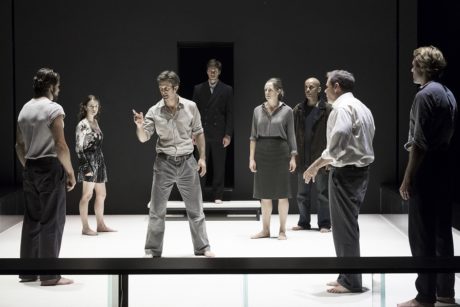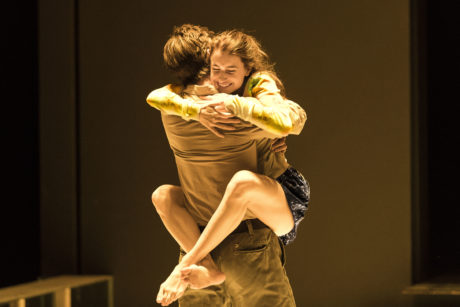The stripped-down, minimalist and auteur-driven interpretation of Arthur Miller’s A View from the Bridge delivers a tragic, elemental, and mythic dimension to this stirring play that delineates the fatal flaws of its lead character, Eddie Carbone (played with the authentic feel of the human condition and a quirky deadpan delivery by the versatile actor Frederick Weller).

A struggling Italian family encounters the complexities and moral contradictions that one would normally find in a Greek Tragedy —thanks to this extremely radical deconstruction of this Arthur Miller play by the gifted and Tony-Award winning auteur-driven Directorial style of Ivo Van Hove.
The explosive essences of the characters are laid bare as the brilliantly intellectual Van Hove shoots down any of the preconceived notions one might bring to this play. Anticipated and reactionary responses are often waylaid in favor of the psychological essences and attitudes of the characters being laid bare before the audience. Homoerotic and incestuous passions are handled with sensitivity and an unerring acuity but are never sensationalized.
Mr. Van Hove draws from the ancient traditions of Japanese Noh Theatre to break down any blockage between the audience and the actors in order to provide maximum immersion in the proceedings. The stage consists of a central playing space with the audience seated to the left and right of the players onstage as well as in the regular Theater seating. The very minimalist and functional squarely –shaped set opens and closes like a gigantic “Bento Box.” Scenic and Lighting Designer Jan Versweyveld works in an ingenious fashion.
Actors often perform in bare feet, regardless of their modern attire (many of the colors are in earth tones —Costume Designer An D’Huys makes some interesting choices). Physical gestures are precise and pronounced from the joyous embracing and clasping of the feisty Catherine (a fine performance by Catherine Combs mixing the tart, the callow and the softer nuances of her character) to the grand sweeping gestures of the flamboyant Rodolpho (played with charisma yet sensitive calibration by Dave Register).
The very natural acting style of Andrus Nichols as the patient and “world-weary” wife Beatrice and the strong physical authority that Alex Esola brought to the character of the immigrant Marco must be mentioned. Nichols shone vividly in her scenes begging her husband to let go of his feelings for his niece. Mr. Esola was mesmerizing as he held a chair to the skies in a display of almost spiritual physicality. Bathed in white light by Mr. Versweyveld’s lighting, this scene was an emotional highlight.
Director Van Hove strives for an ensemble feel as his vision hovers over this play like a probing laser beam. He truly and skillfully almost deceives the audience initially by setting up the beginning scenes in a deceptively austere, plain and direct fashion —slowly letting the specific acting choices of the actors convey the essences of their characters through precise movements and gestures. Soon, however, I realized that Mr. Van Hove was presenting successive layers of complexity to the audience almost akin to “the peeling of an onion” to its very core.
As Van Hove delved deeper into the moral complexity and psychological flaws of the lead tragic character, Eddie—probing and fatalistic foreshadowing became all the more apparent and the play opened -up organically to a rich and potent mix of sexual tension, moral compromise and pent-up rage.

This heady mix of emotions is all the more potent because Mr. Van Hove does not condescend to his characters and, conversely, he does not elevate them beyond their human foibles. Truth be told, Van Hove does link his characters up with Greek tragic figures —especially with the lead character, Eddie (Mr. Weller) who cannot grasp the reason beyond his own passions and in the figure of the lawyer, Alfieri (a standout performance of gravitas by Thomas Jay Ryan) who functions as a one-man “Greek Chorus” —–but Van Hove balances this by having his characters interact in a guileless, matter –of-fact manner. As the characters sauntered around the stage and conversed in such a direct and natural manner, I was left astounded and transfixed by the clever theatrical maneuverings that were soon to descend upon us as the tragic conclusion of the play approached.
From the beginning of the play to the tragic conclusion, an ingenious use of music was presented in three distinct patterns by Sound Designer Tom Gibbons. Initially, as the characters converse, we hear a hushed almost-ethereal form of religious chanting that produces a “reverie-like” ambience. Then, as the tragic foreshadowing of the play unspools into sexual tensions and physical posturing, rhythmic drum beats produce a steely cadence and air of foreboding. In the final sections of the play, the musical passages that are chosen have the emotional operatic style of a dramatic aria which adds to the dissonance, discordance and final catharsis of this drama.
I cannot stress enough that the linchpin of this play is the superb playing of Mr. Weller as Eddie. I continually saw the elements of the “everyman” in Mr. Weller’s performance —a hard working longshoreman who is made into a tragic figure by virtue of his blind passions and his continual justifications for his reactionary prejudices.
The harrowing conclusion stirs not only on an aesthetically visual level but, concurrently, as —perhaps—-a commentary on “collective guilt” for nobody is guilt –free in a world of moral complexity and compromise. As a character cradles her dying husband in her arms, the pose resembles nothing less than Michelangelo’s Pieta and one is moved to pensive thoughts indeed.
Mr. Van Howe’s visionary and guiding hand has given us A View From the Bridge of emotional, visceral, and explosive power.
Kudos to The Kennedy Center for presenting this powerful play to the DC Metro Region’s artistic and theatre-going community!
Running Time: Approximately two hours, with no intermission.
A View From the Bridge plays through Saturday, December 3, 2016, in the Eisenhower Theater at The John F. Kennedy Center for the Performing Arts – 2700 F Street, NW, in Washington, DC. For tickets, call (202) 467-4600, or purchase them online.
LINKS:
Review #1: ‘A View From the Bridge’ at The Kennedy Center by Michael Poandl.
In the Moment: ‘A View From the Bridge’ at The Kennedy Center by David Siegel.
Review #2: ‘A View From the Bridge’ at The Kennedy Center by David Friscic.




